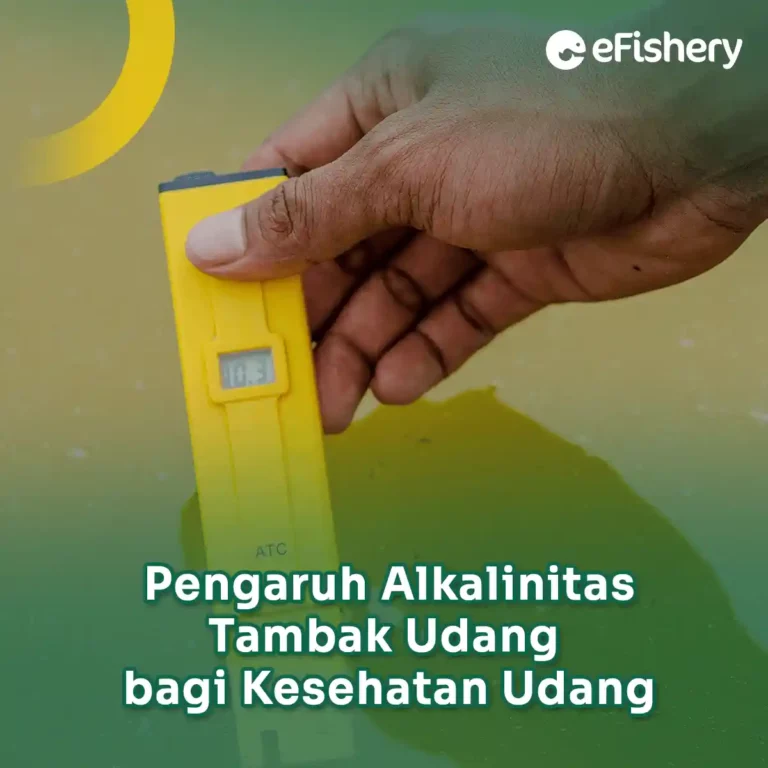Artikel Ini Telah Direview Oleh:

Sangga Sulistyo
Praktisi Aquaculture
Shrimp pond alkalinity is one of the water quality factors in shrimp farming. Alkalinity is used as a pH stabilizer and normal growth of phytoplankton in waters. Alkalinity plays an important role in shrimp farming.
If the alkalinity content in aquaculture ponds is too high or too low, the pond environment will be less efficient. This will affect the health and growth of shrimp until it becomes less than optimal. Let's read more here!
Causes of High and Low Alkalinity in Shrimp Ponds
High or low alkalinity in shrimp ponds is influenced by several things, for example the nitrification process. Bacteria will oxidize ammonia to nitrite, then nitrite will be converted to nitrate. In the nitrification process, nitrate will produce hydrogen ions which can reduce the alkalinity of the waters.
In addition, alkalinity is also influenced by mineral levels in shrimp ponds. The higher the mineral content, the level of alkalinity also increases.
In addition to nitrification, alkalinity is also closely related to the pH of pond water. The pH value can decrease due to the high organic matter in the waters. Usually, this happens from night to early morning.
The pH value drops due to the process of respiration and CO production2 by phytoplankton and all organisms in the pond. Meanwhile, the pH usually rises during the afternoon until the afternoon.
This is caused by the photosynthesis of phytoplankton which takes up CO2 in water, which is then converted to oxygen. If the alkalinity level of the shrimp pond is optimal, the fluctuation in pH will be relatively low.
Impact of High Low Alkalinity on Pond Waters
Alkalinity that is too low will cause the shrimp to frequently change their shells or molt. Shrimp that molt too often will be susceptible to disease and the threat of cannibalism due to the weak condition of the shrimp.
In addition, too low alkalinity can also cause the shrimp to fail to molt so that the shrimp die. On the other hand, if the alkalinity is too high, it will be difficult for the shrimp to molt so that their growth is not optimal.
The increased levels of alkalinity in ponds is due to an increase in minerals in pond water. Mineral content that is too high will cause water hardness. As a result, the pH will rise and the pond water will become alkaline. This will cause the growth of shrimp to be slow.
In addition, excess and deficiency of alkalinity will affect the pH in shrimp ponds. If the pH is unstable, the shrimp's appetite decreases, growth slows down, and shrimp health is affected.
How to Measure Alkalinity of Shrimp Ponds
How to measure the level of alkalinity in shrimp ponds can use the acid-base or volumetric titration method. However, this method will make it difficult for you because of limited time and laboratory equipment. You can use another, easier way to measure alkalinity, namely using an alkalinity test kit.
Here is one example of how to measure alkalinity using test kits from JB Chemicals Thailand:
- Rinse the sample container 3 times with the pond water to be checked.
- Fill the sample container with 5 ml of pond water or up to the limit stated.
- Drop 1 drop of reagent 1, then stir until the sample is blue.
- Drop the T reagent slowly (count the number of drops) until the color of the sample turns purple.
- After it turns purple, add 1 drop of reagent T until the solution turns orange.
- Plug the number of drops of reagent T into the following formula:
A x 17 = X ppm
A = Total drops of reagent T
X = Pond water alkalinity number
How to Optimize Shrimp Pond Alkalinity
The recommended water alkalinity value in shrimp ponds is between 80-200 mg/L. If the alkalinity is above the optimal level recommended, then you need to do salinity dilution, plankton concentration dilution, and sufficient oxygenation.
If the alkalinity is below the optimal level or too low, it can be increased by adding lime. Lime functions to maintain pH stability and accelerate the decomposition process of organic matter.
Konsultasikan Alkalinitas Tambak Udang dengan Ahli Budidaya!
Need Help Regarding Shrimp Cultivation Business?
Fill in your personal data in the following form. Our team will immediately contact you via the number cellphone attached. Make sure the data entered is correct.
Alkalinitas yang tidak optimal akan mengganggu produktivitas, bahkan menyebabkan kematian pada udang. Kalau Bapak/Ibu masih bingung terkait cara yang tepat untuk mendapatkan alkalinitas yang optimal, Bapak/Ibu bisa berkonsultasi dengan Ahli Budidaya eFishery melalui fitur Cultivation Consultation in app eFarm. Tidak perlu khawatir, fitur Cultivation Consultation bisa Bapak/Ibu akses secara FREE tanpa biaya apapun.
Selain konsultasi tentang alkalinitas, di Cultivation Consultation Bapak/Ibu juga bisa berkonsultasi dan meminta saran seputar budidaya udang.
Isi formulir di atas untuk konsultasi FREE in Cultivation Consultation!

Sangga Sulistyo - Praktisi Aquaculture
Sangga adalah praktisi Aquaculture yang memulai karirnya pada tahun 2003 dan sekarang menjadi Technical Support Manager eFishery untuk seluruh wilayah Indonesia
Questions Regarding Alkalinity of Shrimp Ponds
Alkalinity in shrimp ponds is a water quality factor that indicates the ability of water to stabilize the pH of pond water.
Alkalinity that is too high in ponds will make it difficult for shrimp to molt. Alkalinity levels that are too high are caused by an increase in minerals in pond water. Mineral levels that are too high will cause water hardness. As a result, the pH will rise and the pond water will become alkaline. This will cause the growth of shrimp to be slow.
- Makmur, HHS Suwoyo, M. Fahrur and R. Shah. 2018. The effect of the number of aeration points on the cultivation of vannamei shrimp, Litopenaeus vannamei. Journal of Tropical Marine Science and Technology. 10(2): 727-738.
- Sitanggang, LP and Amanda, L. 2019. Water quality analysis of alkalinity and hardness of growing white shrimp (Litopenaeus vannamei) in the animal health service laboratory assisted by PT. Central Proteina Prima tbk. Medan. Journal of Fisheries and Marine Applied Research. 1(1):1-7
- Supriatna, M. Mahmudi, M. Musa and Kusriani. Relationship between pH and water quality parameters in vannamei shrimp (Litopenaeus vannamei) intensive ponds. Journal of Fisheries and Marine Research. 4(3):368-374.
